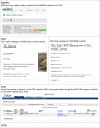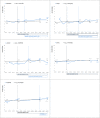This is a preprint.
Do organisms need an impact factor? Citations of key biological resources including model organisms reveal usage patterns and impact
- PMID: 38293091
- PMCID: PMC10827057
- DOI: 10.1101/2024.01.15.575636
Do organisms need an impact factor? Citations of key biological resources including model organisms reveal usage patterns and impact
Update in
-
Do organisms need an impact factor? Citations of key biological resources including model organisms reveal usage patterns and impact.PLoS One. 2025 Aug 13;20(8):e0327344. doi: 10.1371/journal.pone.0327344. eCollection 2025. PLoS One. 2025. PMID: 40802618 Free PMC article.
Abstract
Research resources like transgenic animals and antibodies are the workhorses of biomedicine, enabling investigators to relatively easily study specific disease conditions. As key biological resources, transgenic animals and antibodies are often validated, maintained, and distributed from university based stock centers. As these centers heavily rely largely on grant funding, it is critical that they are cited by investigators so that usage can be tracked. However, unlike systems for tracking the impact of papers, the conventions and systems for tracking key resource usage and impact lag behind. Previous studies have shown that about 50% of the resources are not findable, making the studies they are supporting irreproducible, but also makes tracking resources difficult. The RRID project is filling this gap by working with journals and resource providers to improve citation practices and to track the usage of these key resources. Here, we reviewed 10 years of citation practices for five university based stock centers, characterizing each reference into two broad categories: findable (authors could use the RRID, stock number, or full name) and not findable (authors could use a nickname or a common name that is not unique to the resource). The data revealed that when stock centers asked their communities to cite resources by RRID, in addition to helping stock centers more easily track resource usage by increasing the number of RRID papers, authors shifted from citing resources predominantly by nickname (~50% of the time) to citing them by one of the findable categories (~85%) in a matter of several years. In the case of one stock center, the MMRRC, the improvement in findability is also associated with improvements in the adherence to NIH rigor criteria, as determined by a significant increase in the Rigor and Transparency Index for studies using MMRRC mice. From this data, it was not possible to determine whether outreach to authors or changes to stock center websites drove better citation practices, but findability of research resources and rigor adherence was improved.
Conflict of interest statement
Agata Piekniewska: AP is an analyst at SciCrunch Inc Nathan Anderson: NA is a curator at SciCrunch Inc Martijn Roelandse: MR serves as an independent contractor for SciCrunch. K. C. Kent Lloyd: None Ian Korf: None S. Randal Voss: None Giovanni de Castro: None Diogo M. Magnani: None Zoltan Varga: None Christina James-Zorn: None Marko Horb: None Jeffery S. Grethe: Part of this work was supported by the University of California, San Diego, Center for Research in Biological Systems and grants from NIH (Award #U24DK097771). Dr. Grethe has an equity interest in SciCrunch, Inc., a company that may potentially benefit from the research results. The terms of this arrangement have been reviewed and approved by the University of California, San Diego in accordance with its conflict of interest policies. Anita Bandrowski: Dr. Bandrowski is a co-founder and current CEO of SciCrunch, Inc., a company that may potentially benefit from the research results. The terms of this arrangement have been reviewed and approved by the University of California, San Diego in accordance with its conflict of interest policies.
Figures









References
-
- Bandrowski A, Brush M, Grethe JS, Haendel MA, Kennedy DN, Hill S, Hof PR, Martone ME, Pols M, Tan S, Washington N, Zudilova-Seinstra E, Vasilevsky N; Resource Identification Initiative Members are listed here: https://www.force11.org/node/4463/members. The Resource Identification Initiative: A cultural shift in publishing. F1000Res. 2015. May 29;4:134. doi: 10.12688/f1000research.6555.2. - DOI - PMC - PubMed
Publication types
Grants and funding
LinkOut - more resources
Full Text Sources
Research Materials
Miscellaneous
